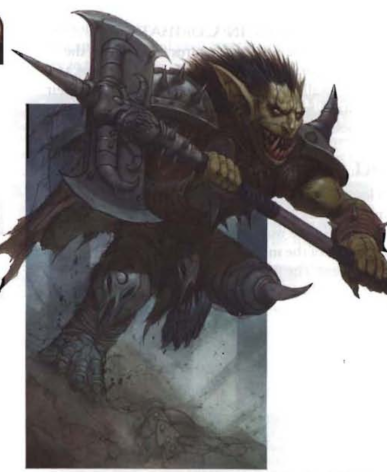Let's Read the 4e Monster Manual 3: Tannarukk

This post is part of a series! Click here to see the other.
This one feels like an AD&D 2nd Edition creation, as that’s when they renamed demons as “ta’nari”.
The Lore
Tannarukk are engineered hybrids of orc and demon DNA, the product of rituals performed by demon lords or ambitious mortal spellcasters. These rituals are effectively a mass-production process, as they involve pulsing vats and can create dozens of the creatures at once. In most cases they’re immediately put to work as soldiers and weapons of war, though they’re extremely difficult to keep under control unless they get “enough” opportunity to commit violence. As you might expect, that’s a tall order.
The few free tannarukk bands that exist tend to seek work as mercenaries. Free or not, they can most often be found in the Astral Sea or Elemental Chaos, usually fighting something. They do sometimes show up in the middle world, and they love it because few warriors there can match their skill and resilience in combat.
The Numbers
Tannarukks are Medium Elemental Humanoids with the Demon and Orc keywords. They have Darkvision and Speed 6, along with Resist Fire 5. Their signature trait is Indomitable Fury, which kicks in when they drop to 0 HP for the first time in the fight. It makes them stay at 1 HP instead and gives them +2 to attacks and +4 to damage until the end of the encounter.
This means the PCs should make sure each Tannarukk in the encounter stays down by hitting it again before it can get a chance to take more actions. If they don’t, they’re going to take more damage; if they do, that’s one attack that didn’t go to a healthier monster.
Tannarukk Marauder
Most tannarukks conform to this stat block, which is your basic enthusiastic axe murderer. Marauders wear hide and wield a greataxe, and can also thrown handaxes at those they can’t quite reach.
Their Nimble Reaction trait gives them +4 AC against opportunity attacks, which is good because their signature move relies on fishing for them: Brutal Rampage allows them to move their speed and make a greataxe attack at any point during the move. This attack gains a +5 damage bonus for each opportunity attack made against the marauder during the move (but before the attack). The opportunity attacks don’t need to hit, they just need to happen.
Tannarukk Steel Warrior
This is a bigger tannarukk that received better training and had armor riveted to its hide. It’s a Level 18 Soldier with 177 HP. Its armor counts as plate, and it wields a shield and a Longsword, plus a Crossbow for ranged attacks.
The sword marks for a turn, and the warrior can make free attacks against enemies that ignore the mark. It can also be used in a special attack named Burning Cage (recharge 5+). This melee attack targets Reflex and does heavy fire damage. The target takes a further 5 fire damage every time it enters a square during its turn (save ends).
Tannarukk Flame Speaker
This is a tannarukk spellcaster whose power relies on a connection to the abyssal flames that go into their production ritual. It’s level 17 Artillery with 129 HP and resist 10 fire, a bit higher than usual for them.
The flame speaker fights with a Staff in melee, and with fire bolts at range. It can also shoot a fire barrage (recharge 5+) that targets up to three creatures but does a bit less damage than the basic bolt.
Once per encounter, the flame speaker can summon Winds of Fire, an area burst attack that deals fire damage and creates a zone that lasts for the rest of the encounter. Anyone starting their turn inside takes 10 fire damage and is pulled 1 square towards the zone’s origin square.
In addition to Indomitable Fury, the flame speaker also has Avenging Fire, which triggers when it hits 0 HP for the second time. It deals some automatic fire damage to the triggering enemy.
Final Impressions
These stat blocks take up a lot of space on the book, but they’re simpler than they look. Each one has a solid gimmick and appropriate base stats. I guess tannarukks are meant to be regular enemies for upper paragon PCs - stronger than minions, but you’ll still meet a lot of them.
Lore-wise, I’m not sure I like them. They’re more or less D&D’s take on the Uruk-Hai, I guess, but there are a lot more opponents at this level range that feel cooler and less potentially problematic.